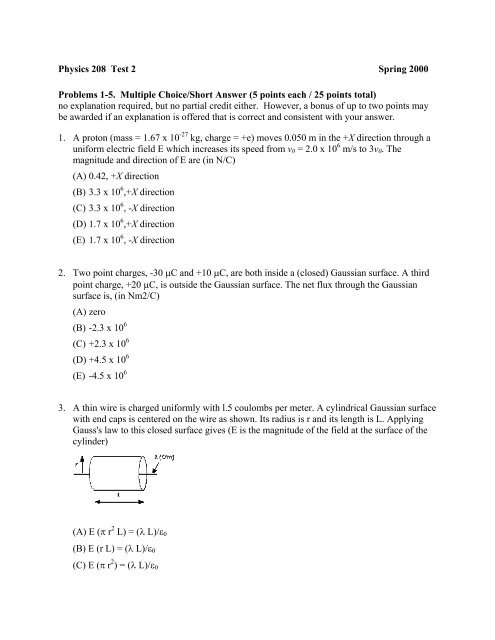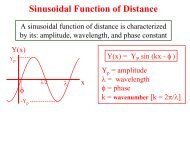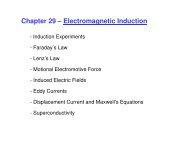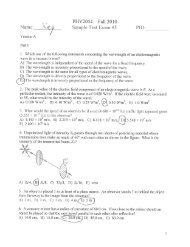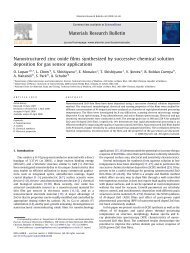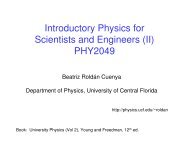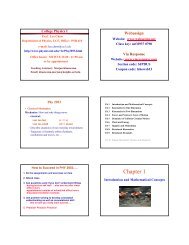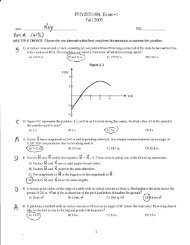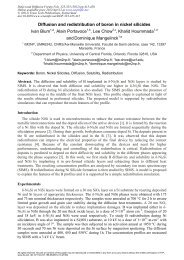Test 2 - UCF Physics
Test 2 - UCF Physics
Test 2 - UCF Physics
You also want an ePaper? Increase the reach of your titles
YUMPU automatically turns print PDFs into web optimized ePapers that Google loves.
<strong>Physics</strong> 208 <strong>Test</strong> 2 Spring 2000<br />
Problems 1-5. Multiple Choice/Short Answer (5 points each / 25 points total)<br />
no explanation required, but no partial credit either. However, a bonus of up to two points may<br />
be awarded if an explanation is offered that is correct and consistent with your answer.<br />
1. A proton (mass = 1.67 x 10 -27 kg, charge = +e) moves 0.050 m in the +X direction through a<br />
uniform electric field E which increases its speed from v 0 = 2.0 x 10 6 m/s to 3v 0 . The<br />
magnitude and direction of E are (in N/C)<br />
(A) 0.42, +X direction<br />
(B) 3.3 x 10 6 ,+X direction<br />
(C) 3.3 x 10 6 , -X direction<br />
(D) 1.7 x 10 6 ,+X direction<br />
(E) 1.7 x 10 6 , -X direction<br />
2. Two point charges, -30 µC and +10 µC, are both inside a (closed) Gaussian surface. A third<br />
point charge, +20 µC, is outside the Gaussian surface. The net flux through the Gaussian<br />
surface is, (in Nm2/C)<br />
(A) zero<br />
(B) -2.3 x 10 6<br />
(C) +2.3 x 10 6<br />
(D) +4.5 x 10 6<br />
(E) -4.5 x 10 6<br />
3. A thin wire is charged uniformly with l.5 coulombs per meter. A cylindrical Gaussian surface<br />
with end caps is centered on the wire as shown. Its radius is r and its length is L. Applying<br />
Gauss's law to this closed surface gives (E is the magnitude of the field at the surface of the<br />
cylinder)<br />
(A) E (π r 2 L) = (λ L)/ε 0<br />
(B) E (r L) = (λ L)/ε 0<br />
(C) E (π r 2 ) = (λ L)/ε 0
<strong>Physics</strong> 208 <strong>Test</strong> 2<br />
Name & Group<br />
(D) E (π r 2 L) = (λ π r2)/ε 0<br />
(E) E (2πr L) = (λ L)/ε 0<br />
4. A +20 µC point charge moves 2 m parallel to a uniform electric field of magnitude<br />
6.0 x 10 5 N/C. The work done on the charge by the electric field is<br />
(A) 48 Nm<br />
(B) 12 Nm<br />
(C) 6.0 Nm<br />
(D) 24 Nm<br />
(E) 1.2 x 10 6 Nm<br />
5. A circular ring of charge is made by joining four-quarter circles, each having the same<br />
magnitude of charge as the others. Each quarter circle has its net charge uniformly distributed<br />
over its length. Let the field at the center of the circle due to one quarter circle be E 1 . The<br />
magnitude of the total electric field at the center is then<br />
(A) zero (B) E1 (C) 2 E1 (D) 3 E1 (E) 4 E1<br />
6. Essay (15 points): You may use diagrams and equations but no calculations for this problem.<br />
A positively charged conducting sphere of radius 2m is inside a conducting shell as shown<br />
below. There is an air gap between the two spheres. The spherical conducting shell has no net<br />
charge on it. Sketch a graph of the E-field as a function of the radial distance r (an E-field vs. r<br />
graph). Explain why the graph appears as you have drawn it.<br />
1
<strong>Physics</strong> 208 <strong>Test</strong> 2<br />
Name & Group<br />
7. (GOAL Problem: 20 points) For the following problem, do the G and O steps of GOAL only.<br />
Your O step should include a statement of the main physics principles used, why you are using<br />
them, and how you would use them to solve the problem. Do not solve the problem..<br />
You have landed a summer job working with an Astrophysics group investigating the origin of<br />
high-energy particles in the galaxy. The group you are joining has just discovered a large<br />
spherical nebula with a radius 1.0 million km. The nebula consists of about 5 x 10 9 hydrogen<br />
nuclei (protons) which appear to be distributed uniformly in the shape of a sphere (the protons<br />
are distributed uniformly throughout the sphere. At the center of this sphere of positive charge is<br />
a very small neutron star. Your group had detected electrons emerging from the nebula. A friend<br />
of yours has a theory that the electrons are coming from the neutron star. To test that theory, she<br />
asks you to calculate the E-field inside the nebula as a function of radial distance. From the<br />
inside cover of your trusty physics text you find that the charge of a proton (and an electron) is<br />
1.6 x 10 -19 C, the mass of the proton is 1.7 x 10 -27 kg, and the mass of the electron is 9.1 x 10 -31<br />
kg.<br />
Find the E-field at a distance of half the radius of the nebula.<br />
GOAL Problem-solving Protocol<br />
Gather information:<br />
What is known? What are you looking for?<br />
Predict a reasonable answer with units. (Consider limiting cases.)<br />
Organize your approach:<br />
Draw a diagram(s) labeled with variables from G step.<br />
Classify the problem according to the general physics principle(s) used.<br />
Describe how you will use the general principle(s) to solve the problem.<br />
2
<strong>Physics</strong> 208 <strong>Test</strong> 2<br />
Name & Group<br />
8. (20 points) Two very large positively charged sheets are placed a distance 3d apart (only a<br />
small portion of the plates is shown). The sheet on the left has an area charge density of +3σ 0<br />
and the sheet on the right has area charge density -σ 0 .<br />
A. Find the net electric field vector at points A (at a distance d to the right of the right plate)<br />
and B (at a distance d to the left of the right plate).<br />
B. What is the minimum amount of work you would have to do to move an electron from<br />
the + sheet to the negative sheet.<br />
+3σ 0<br />
3
<strong>Physics</strong> 208 <strong>Test</strong> 2<br />
Name & Group<br />
8. Suppose a hole is made in the middle of the positive plate in problem 8. If an electron were<br />
released from the middle of the (–) plate, it would accelerate towards the positive plate.<br />
What speed would the electron have when it passed through the hole in the positive plate.<br />
(This is one of the simplest forms of particle accelerator.)<br />
+<br />
–<br />
4


